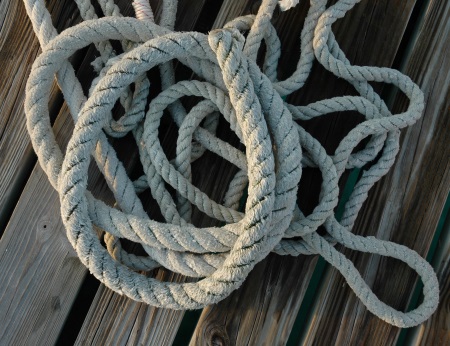Ever wonder why there are so many ways to refer to all the ropes, line, and cordage on a boat? You’re not alone!! Here’s a personal story that explains a lot. The author of the story is Jerry Fultz, who retired from the Sail Care team a while back.
 My wife Sam and I learned this lesson back in the late 70s, when we first got into sailing. We had just taken our first boat (a 22 ft. Venture) out on the lake for only the second time. All in all it went ok; docking was a bit of a challenge but we got it into the slip with no damage. A couple across the dock came over and gave us a hand and invited us over for a cold beer.
My wife Sam and I learned this lesson back in the late 70s, when we first got into sailing. We had just taken our first boat (a 22 ft. Venture) out on the lake for only the second time. All in all it went ok; docking was a bit of a challenge but we got it into the slip with no damage. A couple across the dock came over and gave us a hand and invited us over for a cold beer.
As I stepped from the dock over the lifelines he stopped me. He pointed to the cables holding up the mast, then stepped over the life lines onto the deck of the boat and said “try stepping off the dock onto the boat at the shrouds.” Made sense!
As we took a seat in the cockpit Sam commented that he sure had a lot of ropes on the boat. Both he and his wife stopped and looked at us in open-mouthed amazement. Then he said, “Sam, there are no ropes on a boat – only sheets, lines and halyards!”
We were embarrassed but our host went on to explain how crucial rope/line is on sailboats and how important it is to know what each one is, what it does, and what it’s called.
The ropes that control the sails (both main and jib/genoa) are called sheets. The ropes that pull the main & jib/genoa up into position for use are called halyards. The rest of the ropes are called lines with a name like dock line, outhaul line, reef line, down haul line, Cunningham line and so on.
So “rope” is just is not a good enough term as there are many ropes on a typical sail boat, all of which have specific jobs and names. Knowing and using the right names for various “ropes” is key to efficient sailing. Asking someone to tighten the outhaul line or to ease the sheet on the headsail is a waste of time unless they know what you’re talking about. If they DO know the names, it becomes easy for one person to steer or drive the boat while the crew adjusts the sails to keep the boat on her feet and moving.
It’s also worth noting that color coding the ropes helps a great deal when asking someone to perform a task. For example, it helps to be able to say “It’s the red jib halyard” or “the blue mainsheet”.


